Undiagnosed Remains: Mental Illness in T. Sturge Moore’s ‘King Comfort’ and ‘The Centaur’
© Copyright 2019 Declan McIntosh, Ryerson University
Introduction
The problem of undiagnosed bouts of mental illness—and, furthermore, the varying definition of what insanity is within the context of differing world-views and power structures—continues to plague humanity as literature and culture develop, though it must certainly be said that collective progress has been made upon the issue. What was the conception of mental illness within Victorian England—specifically, the 1890s? What social and political frameworks existed to aid—or abuse—individuals who were seen as mentally unfit; furthermore, what was the definition of insanity at the time? The stories “King Comfort” and “The Centaur” by T. Sturge Moore, published in the second and fifth volumes of the British periodical The Dial, deal with the subtleties of mental illness within the constraints of socio-theological power structures, as characters find their essential notions of self marred and warped by tyrants and polarized perspectives within their proximity. Moore’s stories provide an excellent insight into the literary explorations of mental illness in 1890s England, as well as a cultural backdrop for real events, such as the Lunacy Act of 1890, and Oscar Wilde’s attempt to have his sodomy charges revoked under the defence of mental illness.
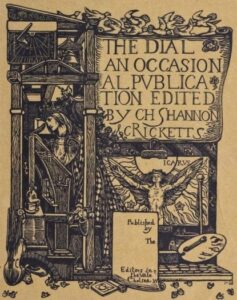
Mental Illness Within “King Comfort’s” Power Structures
Mental illness is often a concept defined by a particular society’s power structures, as in the case of ‘King Comfort’. Here, the King rules in a cut-off feudal state that is not at risk of destruction from external forces: the narrator claims that “this fortress was never shaken by fierce assault” (Moore, 19). From within, just as in cases of madness, is where the deterioration takes place. Throughout this story, we see various characters grappling with rumours of the King’s isolation and invisible rule; the well-winder Gunter goes as far to claim that “good old Comfort’s stone dead” (Moore, 19). The King’s tyranny over the minds of his servants is central to the fact that he doesn’t even need to appear before them to invoke his supremacy; it is a rule of life in the castle, a calm normality that is apparent through the radically shifting, third-person omniscient narrative. Those who live under Comfort’s shadow try, through their varied forays in Carroll-eqsue ‘nonsense books’ and the idle, natural environment surrounding the castle to “develop a meaningful life of their own while within the total institution of the asylum” (du Plessis, 36). An inverted asylum is essentially what King Comfort’s castle is: he, the mad, withdrawn monarch, keeps all those inferior to him under constant scrutiny and stress, only drawing his servants into further levels of madness.
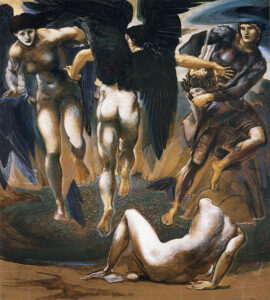
King Comfort and Princess Privacy
It must be noted that the character of Princess Privacy, King Comfort’s daughter, represents “a multiplicity and plurality of resistances that come to the fore in any power relations or relationships” (du Plessis, 24). Her father’s absence and health affects her own relationship with the Prince, whom she will not sleep with, as she is tormented with further rumours of being a witch, much like the rumours of Comfort. However, the dependancy of Comfort in correlation with his daughter is made evident by his only lines throughout the story, which also alludes to his damaged state: “ ‘I’m King Comfort after all / sins I can pardon great and small / and need none handy to my call / Save my dear daughter, Privacy’ ” (Moore, 22). Comfort’s madness needs the isolation, the ‘privacy’, of his chamber to thrive.

The Lunacy Act of 1890
To elaborate on some changes in the psychiatric care system in Victorian England, the Lunacy Act of 1890 can be described by Takabayashi in one sentence: “the 1890 Act established legal control over psychiatric admissions of private patients” (Takabayashi, 249). He goes on to explain the reasoning for the reform: “In 1889, Parliament imposed new legislation on psychiatrists and lunatic asylums under pressure from public anxieties about wrongful confinement, which was engendered by newspapers and journals between the 1860s and 1880s” (Takabayashi, 249), following that up with this information: “The Act also introduced several provisions to prevent wrongful confinement. It guaranteed that patients had both extensive rights to appeal to the authorities and the right to appeal against the justices” (Takabayashi, 250). Within this framework, it was clear that social change—spurred by journalistic exploits which raised public awareness—enacted great institutional reform in 1890s Britain.
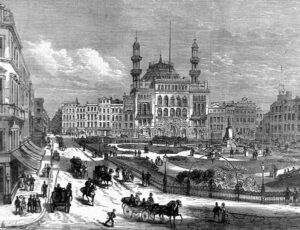
“The Centaur” and its Invisible Gods
As seen often in ‘The Centaur’, with the titular character’s theological conception of his Ancient Greek, naturally-ruled world, the hovering presence of unseen Gods and influencers has a direct affect upon his isolated mental stability. This story, much like ‘King Comfort’, provides in its rural setting and its fantastical, mythic imagery, Moore’s attempt to reach back in humanity’s past to a realm of imagination and possibility; a realm in which the rational mind is not the tyrant of one’s perspective. The narrator, a Centaur who is later revealed to have the name Maracreus, claims early on that “one should withhold and every way shield existence at the outset, counting those days to be engrossed by the gods” (Moore, 16), recounting his isolated upbringing in “the caves of these mountains” (Moore, 16). Even though Bennett, who paraphrases William James in the following passage, claims that “absolute knowledge of the unity underlying reality was unattainable” (Bennett, 89), Maracreus’s existence, much as how Moore imagined those in Ancient Greece must have lived, is confined within a world where “somewhere the jealous gods have buried the evidences of universal descent” (Moore, 20). In this designed, determined world, can free will be said to exist? And if it does not, is this Centaur’s existence not a form of confinement, forever bound to his pre-ordained destiny? Surely, to this character, one of the most helpless forms of mental illness lies in the utter acceptance of such a world.
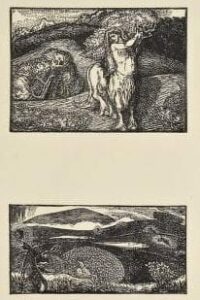
A Centaur’s Polarization: Us And Them
The polarizing ‘Us Versus Them’ worlds that lie at the heart of every conflict, where difference is the focus of perspective instead of similarity, is a clear focus for Maracreus when thinking of himself. Centaurs, being half-men and half-beasts, are intrinsically caught in a ‘world-between’, without either fully belonging to each: as duBois states, “The Greeks used the myth of the Amazons as well as that of the Centaurs to work out and represent a program of differentiation through polarity and analogy” (duBois, 49). Here is a narrative from Maracreus himself, when he encounters his first human in the rural landscape: “I came upon a man making his way along by the river, on its opposite bank. He was the first my eyes had chanced upon: I despised him… ‘there at most,’ said I, ‘is but half of me!’ ” (Moore, 17). Maracreus is opposed the instant he sees this man, which stems from a societal disillusionment within his own being, because he is also an isolated creature who has no conception of society. DuBois notes that “Like Centaurs and Amazoris, the barbarians are held outside the circle of ritual…the bestial , violent, chaotic figures of myth are made analogous to the enemies…they are exiled, placed on the outside to define the farthest boundaries within which the city inscribes itself” (duBois, 95). Maracreus feels a greater kinship with the land itself, a space of “wild and blind waywardness” (Moore, 18), and yet, a place where his identity—for the most part—is unaffected by external forces. At the conclusion of his story, Maracreus denotes a near-total oneness for his environment, thus affording himself a pleasant peace of mind: “I decline into old age calmly…I perceive that I dwindle away and suffer loss rapidly…and that in a little I shall make hence, to be mingled with the rivers that take their way across the vast bosom of the earth” (Moore, 21).
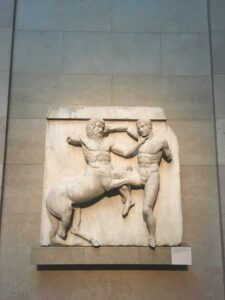
Oscar Wilde and Mental Illness: How Society Shapes The Mind
Within the scope of social relations, the methods of individual behaviour are constantly being scrutinized and modified within the larger, unseen scope of what is deemed socially acceptable: when individuals deviate from society’s norms, mental illness is often the first label placed upon their heads. Concerning the famous case of Oscar Wilde, Janes states in her article that “[Wilde] attempted to use the conceptual realm of mental illness, rather than spiritual illumination, to escape from the constraints of legal classification as a criminal” (Janes, 79). The claim of mental illness was Wilde’s hope to escape physical punishment and deterioration for loving another man. Janes goes on to say that “[Wilde] was, in the language of the time, a ‘criminal lunatic,’ since in that letter he came to conclude that ‘desire at the end, was a malady, or a madness, or both’ ” (Janes, 80), adding that “law and medicine were, in some senses, antagonistic discourses in the nineteenth century insofar as they competed for authority over the bodies of those who had committed a range of deviations from societal norms” (Janes, 81). This is just one of many unfortunate and appalling cases in which something unacceptable at the time—homosexuality—was punished under the guise of mental illness, and the world lost an amazing artist because of it.

Conclusion
The terms of mental illness are so often unhinged and arbitrary that it can be extremely difficult for an individual to assess himself as sane or insane; conversely, it is often his society and environment, spurred by institutional forces, that defines what specifically constitutes a sound mind. Within these terms, this issue is the same today as it was in Victorian England during the 1890s, and while individuals like Oscar Wilde were forced to label themselves insane in order to try and , collective action such as the 1890 Lunacy Act proves that institutional reform was indeed taking place. Within a literary context, “King Comfort” and “The Centaur” by T. Sturge Moore exemplify subtle themes of mental illness and isolation, of reclusive tyrants and their corrosive rule, of saddened, confused, solitary half-men half-beasts who, whether failing or succeeding, all attempt to create and sustain order in a chaotic world. Chaos is the realm of insanity: self-reflection provides the perspective to show just how hazy the lines are between those light and dark mental states.
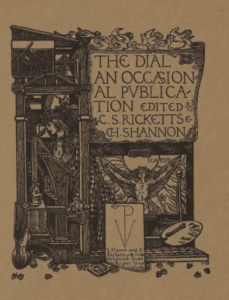
WORKS CITED:
- Bennett, Joshua. “A History of ‘Rationalism’ in Victorian Britain.” Modern Intellectual History, vol. 15, no. 1, 2018, pp. 63–91. Scholar’s Portal, doi: 10.1017/S1479244315000438
- duBois, Page. “Centaurs and Amazons: Women and the Pre-History of the Great Chain of Being.” Ann Arbor: University of Michigan Press, 1991. Project MUSE, https://muse.jhu.edu/book/7171
- du Plessis, Rory. “Photographs from the Grahamstown Lunatic Asylum, South Africa, 1890–1907.” Social Dynamics, vol. 40, no. 1, pp. 12-42. Scholar’s Portal. http://dx.doi.org/10.1080/02533952.2014.883784
- Janes, Dominic. “Oscar Wilde, Sodomy, and Mental Illness in Late Victorian England.” Journal of the History of Sexuality, vol. 23, no. 1, 2014, pp. 79-95. JSTOR. https://www.jstor.org/stable/24616650
- Moore, Sturge T. “The Centaur”. The Dial, Vol. 5, (1897). Y90’s Classroom: https://archive.org/details/dial_05/page/n41
- Moore, Sturge T. “King Comfort”. The Dial, Vol. 2, (1892). Y90’s Classroom: https://archive.org/details/dial_02/page/n47
- Takabayashi, Akinobu. “Surviving the Lunacy Act of 1890: English Psychiatrists and Professional Development During the Early Twentieth Century.” Cambridge University Press, vol. 61, no. 2, 2017, pp. 246–269. JSTOR, doi: 10.1017/mdh.2017.4
